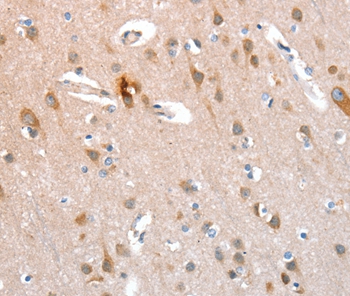

| WB | 咨询技术 | Human,Mouse,Rat |
| IF | 咨询技术 | Human,Mouse,Rat |
| IHC | 1/50-1/200 | Human,Mouse,Rat |
| ICC | 技术咨询 | Human,Mouse,Rat |
| FCM | 咨询技术 | Human,Mouse,Rat |
| Elisa | 咨询技术 | Human,Mouse,Rat |
| Aliases | ECE3; CD238 |
| Entrez GeneID | 3792; |
| Host/Isotype | Rabbit IgG |
| Antibody Type | Primary antibody |
| Storage | Store at 4°C short term. Aliquot and store at -20°C long term. Avoid freeze/thaw cycles. |
| Species Reactivity | Human |
| Immunogen | Fusion protein corresponding to residues near the C terminal of human Kell blood group, metallo-endopeptidase |
| Formulation | Purified antibody in PBS with 0.05% sodium azide. |
+ +
以下是关于KEL抗体的3篇代表性文献及其摘要内容,供参考:
---
1. **文献名称**:*Molecular basis of the Kell blood group system*
**作者**:Lee S, et al.
**摘要**:该研究阐明了Kell血型系统的分子基础,发现KEL抗原是由*KEL*基因编码的跨膜蛋白,并分析了其在不同红细胞表型中的表达差异。研究揭示了KEL蛋白与红细胞膜稳定性及酶活性的潜在关联。
---
2. **文献名称**:*Clinical significance of anti-KEL antibodies in transfusion medicine*
**作者**:Marsh WL, et al.
**摘要**:本文总结了抗KEL抗体在输血中的临床意义,指出抗KEL是继ABO和Rh系统后导致溶血性输血反应的重要原因,强调了抗体筛查及KEL阴性血型匹配在特定患者群体(如孕妇)中的必要性。
---
3. **文献名称**:*Anti-KEL implicated in haemolytic disease of the fetus and newborn: a case series*
**作者**:Bowman JM, et al.
**摘要**:通过多个临床病例分析,研究发现母体抗KEL抗体可穿过胎盘导致胎儿贫血或新生儿溶血病(HDFN),提示需通过产前抗体监测及胎儿血液学评估优化妊娠管理。
---
4. **补充参考(书籍章节)**:
**文献名称**:*Human Blood Groups*(第3版)
**作者**:Daniels G.
**摘要**:书中系统介绍了Kell血型系统的抗原结构、抗体特性及免疫原性,并讨论了抗KEL在输血和妊娠中的临床管理策略。
---
以上文献涵盖了KEL抗体的分子机制、临床影响及管理建议,可作为进一步研究的起点。
The KEL blood group system, first identified in 1946. is one of the most clinically significant human erythrocyte antigen systems. It comprises over 35 antigens, including the highly immunogenic K (Kell) and k (Cellano) antigens, encoded by the *KEL* gene on chromosome 7q34. The KEL glycoprotein is a type II transmembrane zinc-endopeptidase, though its precise physiological role remains unclear. KEL antigens are expressed on red blood cells (RBCs) and, in lower concentrations, on other tissues.
Anti-K antibodies, primarily IgG, are the most common clinically relevant antibodies in this system. They can cause severe hemolytic transfusion reactions (HTRs) and hemolytic disease of the fetus and newborn (HDFN). Unlike Rh antibodies, KEL antigens are developed early in fetal life, increasing HDFN risk. Anti-K antibodies may suppress erythropoiesis in addition to causing hemolysis.
KEL antibodies typically arise from alloimmunization via transfusion, pregnancy, or transplantation. The K antigen (present in 9% of Caucasians, rarer in other populations) is highly immunogenic, necessitating antigen-matched blood for K-negative recipients. Routine pretransfusion testing screens for KEL antibodies, and prenatal care includes monitoring at-risk pregnancies. Advances in molecular typing have improved detection and management of KEL-related incompatibilities, though challenges persist in resource-limited settings. Research continues to explore KEL's biological functions and optimize transfusion protocols.
×